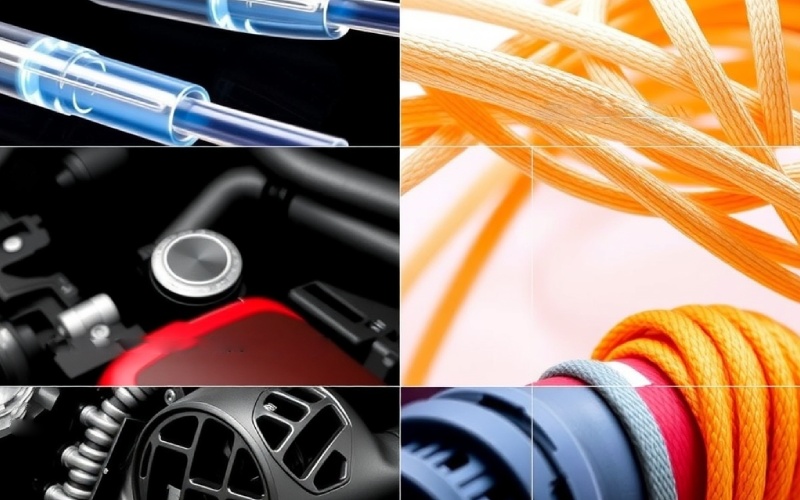Lassen Sie sich von Istar mit unserer Erfahrung und unserem Know-how beim Start Ihres Projekts unterstützen!
Laden Sie Ihre Designdateien und Produktionsanforderungen hoch und wir melden uns innerhalb von 30 Minuten bei Ihnen!

You can find nylon almost anywhere. It’s in the clothes you wear and in the parts of your car. But here is something important: there is not just one kind of nylon. There are many different kinds. Each one has its own special features. In this article, I will show you the different types of nylon. I’ll explain what makes them special. I’ll also help you learn how to pick the right one for what you need. This is a look into a material that has really changed the world we live in.
When I began to learn about materials, I heard the word nylon all the time. It is a name for a large group of man-made polymers called polyamides. You can think of it like this: a polymer is like a long chain. It’s made of smaller parts linked together. For nylon, these links are called amide bonds. This special way the parts are put together is what gives nylon its great strength and makes it last a long time.
The story of nylon started with a search. People wanted to make a material in a lab that could be used instead of silk. The first type of nylon that was made is a thermoplastic. This means you can heat it until it melts. Then, you can shape it into new things. This is a very big plus for making products. It can be a small gear for a machine. It can also be a strong cloth for a parachute. The power to melt and mold makes nylon so helpful. This material can be pulled into a thin fiber or shaped into a hard object. That is why it is used for so many things.
The story of how nylon was invented is very interesting. It takes us back to the 1930s. A very smart chemist named Wallace Carothers worked for the DuPont chemical company. He was the leader of a research group trying to create new materials. In those days, the United States bought most of its silk from Japan. But the relationship between the countries was getting difficult. So, America needed a man-made material to use instead. Carothers and his group were trying new things. They were studying polymers at a time when people did not know much about these huge molecules.
They worked hard for many years. Then, in 1935, Carothers and his team were finally able to synthesize the very first nylon. It was later called nylon 66. This new material was called a “miracle fiber,” and it was easy to see why. DuPont said it was “as strong as steel, as fine as a spider’s web.” The first things made from this new synthetic fiber were bristles for toothbrushes. The most famous product was women’s stockings. When nylon stockings were shown at the 1939 New York World’s Fair, they were a huge hit. This was the start of a big change in the textile world.

One of the most common grades of nylon you will find is Nylon 6. It is a real workhorse in the world of plastics. You can see it in all kinds of things, from car parts to clothes. The reason Nylon 6 is so common is that it has a great mix of features. It has high tensile strength. This means it can handle a lot of pulling force before it breaks. It is also very tough and does not break easily if it is hit.
The way Nylon 6 is made is also special. Many other kinds of nylon are made by a method called condensation polymerization. But Nylon 6 is made by a different chemical method called ring-opening polymerization. This gives it its own unique features. One of the best things about Nylon 6 is its good elasticity and how easy it is to dye. This makes it a top pick in the textile industry. It is used for things like workout clothes and carpets. But, you should know that it does absorb moisture. This can change its size and shape a little in some uses.
When a job needs something with extra strength and that will last a long time, I often choose Nylon 66 (you can also write it as PA 66). This was the very first type of nylon that Wallace Carothers made at DuPont. It became the model for great performance. The “66” in its name tells us how it is made. It comes from two different building blocks, and each one has six carbon atoms. Because of the way its molecules are built, Nylon 66 has a higher melting point. It is also stiffer than Nylon 6.
Because of its great mechanical properties, Nylon 66 is a top pick for uses that need high strength, stiffness, and the power to handle heat and chemicals. You will find it in many industrial and automotive parts. These include gears, bushings, and parts for engines. It is also used a lot to make strong textiles, like for carpets, airbags, and bags. Both Nylon 6 and Nylon 66 are very useful. But the extra strength and ability to handle higher heat of pa 66 make it the right choice for tougher jobs.
Nylon 6 and Nylon 66 are the kinds you will see most often. But there are other, more special grades of nylon too. One of these is Nylon 510. This special type of nylon was also made by DuPont. It was first created as another option for Nylon 66. Nylon 510 is made by mixing pentamethylene diamine and sebacic acid.
What makes Nylon 510 different is its superior strength and durability. But, it costs a lot more to make. This has meant it is not used as much for everyday things that are made in large numbers. Because of this, you are more likely to see Nylon 510 used for special jobs in factories and science labs. These are places where its great features are very important. It is a good example that shows the world of nylon is much bigger than the common kinds we see every day. For jobs where how well it works is key and cost is not the main worry, Nylon 510 is a great, high-quality pick.
The fact that nylon can be used for so many things is amazing. A big reason for this is the different ways it can be processed. Because it is a thermoplastic, nylon can be heated until it melts. Then it can be shaped into many kinds of parts and products. One of the most common ways is injection molding. In this method, melted nylon is pushed into a mold. This creates very exact and detailed parts, like gears, bearings, and parts for cars. The low melt viscosity of some grades of nylon makes them work very well for injection molding.
Another common way to make things is extrusion. In this method, melted nylon is pushed through a special opening to make long shapes like fibers, sheets, and tubes. This is how the synthetic fiber for clothes and carpets is made. In the last few years, 3D printing with nylon has also become very popular. It is used to make test models, called prototypes, and custom machine parts. The ability to use nylon in methods like CNC machining and 3D printing lets us make parts with very specific design features and exact measurements.

A common question I am asked is about how well nylon does in tough places. The good news is that most grades of nylon have great chemical resistance. They can handle many different kinds of chemicals. This includes oils, fuels, and many kinds of solvents. This is why nylon is widely used in the automotive world for parts like fuel lines. But, it is good to know that strong acids can damage nylon.
When we talk about heat, the temperature resistance of nylon is different for each type. For instance, Nylon 66 has a higher melting point than Nylon 6. This makes it a better pick for jobs that deal with high temperatures. The ability of nylon to work well in high temperatures is a main reason it is so valued for car parts under the hood and for electrical parts. The natural toughness and chemical resistance of the nylon polymer make it a material you can count on for many hard jobs.
When you pick a material for a job, it is very important to understand its mechanical properties. Nylon is famous for its amazing strength and durability. It has a high tensile strength. This means it can handle being pulled hard without breaking. This feature, along with its great toughness and ability to resist wear, makes nylon a wonderful material for parts that get a lot of use. Examples are gears, bushings, and wear pads.
The chart below gives a quick look at the main mechanical properties of Nylon 6 and Nylon 66:
| Eigentum | Nylon 6 | Nylon 66 |
|---|---|---|
| Zugfestigkeit | Hoch | Sehr hoch |
| Steifigkeit | Gut | Ausgezeichnet |
| Toughness | Ausgezeichnet | Sehr gut |
| Schmelzpunkt | about 215°C | about 252°C |
It is also good to know that the mechanical properties of nylon can be made even better. This is done by adding things like glass fibers. This makes an even stronger and stiffer material. It can then be used in jobs that have very heavy loads. The yield strength and other performance parameters of nylon make it a top pick for many types of engineering work.
One key thing to know about nylon is that it tends to absorb moisture. This happens because the amide groups in the polymer chain are drawn to water. When nylon takes in water, it can change its dimensional stability and some of its strength features. This moisture absorption can make the material get a little bigger. It can also make it a bit softer and more bendy.
Different grades of nylon take in water at different speeds. For example, Nylon 6 usually will absorb more water than Nylon 66. There are also special kinds of nylon, like Nylon 12. These are known for taking in very little water. For jobs where keeping the exact size is very important, you should pick a type of nylon that absorbs less moisture. Or, you can plan for the changes that water will cause. For many jobs, though, the amount of water that standard nylon takes in is not a big problem.
There are so many different grades of nylon you can get. So, how do you know which one to pick? The answer really comes down to what your project needs. If you are looking for a material that is good for many uses, does not cost too much, and has good all-around features, Nylon 6 is usually a great pick. It is a popular choice for all kinds of things, from clothing items to things we use every day.
But, if your job needs more strength, more stiffness, and the power to handle higher heat, then Nylon 66 is probably the better choice. Its better mechanical properties make it perfect for tougher jobs in factories and for automotive parts. And if you need a material that works exceptionally well and takes in less water, you might look at a more special type of nylon like Nylon 510 or Nylon 12. The important thing is to think hard about the performance you need. This includes things like strength and durability, temperature resistance, and dimensional stability. This will help you choose the best nylon for your work.
To sum it up, the world of nylon is big and has many options. It started as a way to replace silk in a stocking. Now it is used in high-tech parts for airplanes and cars. This amazing synthetic polymer is still a very important material in our world today. I hope this guide has helped you get a better idea of the different types of nylon and what makes each one special.